A day in the life of a lamprey lab
Posted by Tyler Square, on 9 December 2015
My name is Tyler Square, and I am a PhD student in the Medeiros Lab at the University of Colorado at Boulder in the Ecology and Evolutionary Biology department. Also in the Medeiros lab is David Jandzik, a postdoc who was kind enough to provide most of the media for this post. Our lab primarily studies the evolution of development (evo-devo) in vertebrates, with a focus on structures and developmental processes in the head. I personally focus on the evolution of neural crest cells, which are a really cool (and really weird) cell type that contributes to a whole slew of diverse structures in vertebrates: neurons and glia of the peripheral nervous system, cartilage and bone of the head skeleton, smooth muscle of the heart, pigment cells, and more!
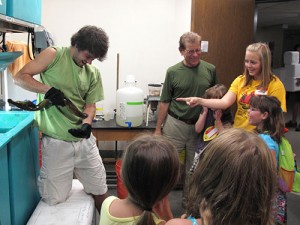
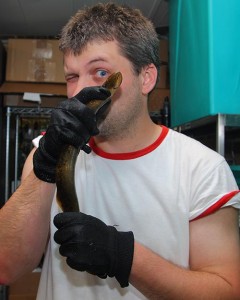
In order to have a complete view of vertebrate evolution, it is important to use a diverse sampling of vertebrates. This helps us infer when certain developmental processes evolved, or how particular lineages might have undergone specialization. To these ends, our lab uses zebrafish, Xenopus laevis, and the sea lamprey (Petromyzon marinus) as vertebrate models, and amphioxus (Branchiostoma floridae) as an invertebrate chordate outgroup (closely related to vertebrates).
Lampreys are surely our most charismatic model organism, and they are phylogenetically positioned in a very favorable spot for our purposes. Much work has already been done in jawed vertebrate (gnathostome) models like zebrafish, Xenopus, chicken, and mouse, so by understanding lamprey development we can get a more complete picture of how vertebrate development evolved. Sea lampreys are part of a vertebrate group called the cyclostomes (which comprise only lampreys and hagfish) that are well-supported as the sister group to gnathostomes; thus, all lamprey and hagfish are the vertebrate animals most distantly related to you!
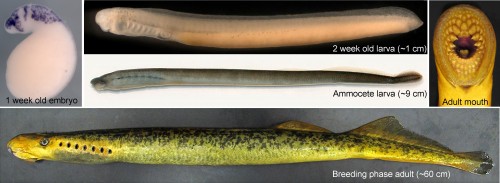
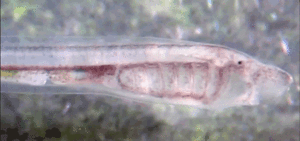
Sea lampreys have a rather complex life history, and it helps to be familiar with this since it dictates how we are able to use them in a lab setting. Some aspects of their biology make them ideal for use as a developmental model, whereas other aspects are far from ideal. Their entire lifecycle takes somewhere between 5 and 11 years to complete. Most of this uncertainty comes from the duration of their filter feeding larval stage, called an ammocete. Once hatched, these small (~1 cm) ammocete larvae enter a blind, mostly burrowed phase of suction feeding on detritus and algae that lasts somewhere between 3 and 10 years depending on the locality. Metamorphasis occurs after this filter feeding stage when the lamprey are ~12 cm, which is when the animals develop eyes and teeth. These now parasitic juveniles swim out to a nearby ocean or lake and look for a series of hosts for 12-20 months of bloodmeals. By feeding on a series of hosts, they attain a wide range of final adult sizes from as small as 35 cm to as large as 90 cm. This range again reflects locality: populations confined to lakes tend to be smaller on average, while individuals in those populations connected to the ocean can attain much larger sizes. Since our breeding phase adults come almost exclusively from the Great Lakes, the majority of the adults in our lab are between 50 and 60 cm. Sea lampreys then enter their adult breeding phase lasting a few months where they completely stop eating, swim back upstream to build a nest, and spawn. Adult sea lampreys die usually within a week of spawning.
Due to the length of this lifecycle and the micropredatory feeding strategy during the juvenile stage, no laboratory or marine facility has ever housed a complete sea lamprey lifecycle. This means that no inbred or stable transgenic lines of sea lamprey (or any cyclostome, for that matter) exist anywhere, making some of the fancy tools developed in more common developmental models like zebrafish or mouse out of reach.
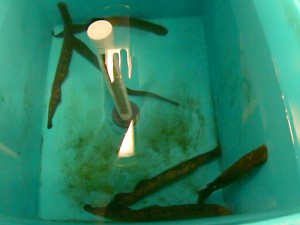
Most labs like ours that study sea lamprey embryology get shipments of adult spawning phase lamprey starting in mid-June, which were trapped in streams. Most US labs, including ours, get lampreys from the Hammond Bay Biological Station in Millersburg, MI. We hold these animals in large tanks with an ample rate of water turnover, as the animals still exude waste despite that fact that they are no longer eating (and won’t eat again before they naturally die in our hands). Our lab is usually home to around 50 adults at any given time, split into three ~350 liter tanks. We like to have slightly more than half of our animals be females, but we don’t always have much of a choice. Usually by mid- to late August, all of the adults that came through our lab have completed their lifecycle, and have perished naturally.
Around half of the days during the ~10 week “lamprey season” are injection days. To get sea lamprey zygotes, gametes are manually stripped from the live adults and put on glass dishes with a little bit of system water in them. At any given time during lamprey season we typically have up to three females in their prime egg-laying stage while we wait for the others to ripen. So on a normal day in the height of the season, a typical fertilization bout will use one or two proven females to make a few big, injectable batches of eggs (~3,000), while also doing some small test fertilizations of another few females who might be ripe (~200 eggs). Some females never give us good eggs, and will instead tempt us with eggs that don’t fertilize, or ones that do but the resulting embryos most frequently die at day three or four (during or just after gastrulation). Some females will never even give us eggs at all before they die. Other females will give us 30,000-50,000 good eggs over the course of their two to five day prime. But even with these optimal females, eggs lain before or after the viable eggs will sometimes be poor. The males tend to be easier to work with, and can also last for much longer in their prime breeding stage; some males have lasted up to three weeks, cementing their legacy in our lab as the sire to more than 100,000 embryos! Once we have a good, proven male, we tend to use him alone to perform fertilizations, but before proving out a male we will combine the sperm of three or four males during one fertilization event (since sometimes males shed only very small amounts of sperm).
Movie 1: Fertilization. A short video on how we manually strip gametes from males
and females
Daily tasks during the lamprey season are split between the adult care, which is minimal, and the embryo care, which can be rather time consuming. The adults require daily checks, as dead animals need to be collected soon after they perish as to prevent system contamination. We also do ammonia tests periodically to ensure that the water changes are sufficiently removing waste from the holding tanks.
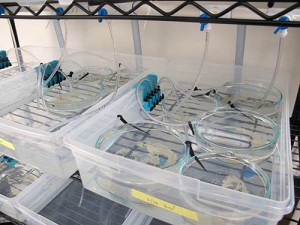
The embryos command the majority of our attention. On a typical day with a good, fertile female, we spend four to six person hours injecting embryos, and two to eight person hours ‘sorting’ the previously-injected and wildtype embryos. We sort the embryos both to remove dead material, and also under a fluorescent microscope to select those individuals exhibiting visible lineage tracer, indicating that they were successfully injected. We usually inject up to 30-40 µl of injection solution into 6,000-8,000 zygotes on a good injection day.
Movie 2: Microinjection. A video showing the setup for injecting lamprey zygotes.
As you might imagine, working with lamprey is a dream when the eggs and embryos are healthy. In one sitting using CRISPR we can potentially generate hundreds or even thousands of sea lamprey that are mutant for a given gene of interest. If survival is good, this becomes enough material for both in situ hybridization (ISH) on multiple genes at multiple stages of development, and genomic DNA from presumed mutants for analysis of the targeted loci. However, our most recent 2015 season was a better example of the converse egg quality situation: while we did eventually have some successful rounds of injection, the first month or so of lamprey season was full of females giving us eggs that were almost unanimously destined for death on day four. This meant many, many hours injecting and sorting embryos that yielded little or no useable data. It’s not unusual for us to happen upon a female with poor egg quality every now and then even during a good season, but to spend so many hours under a microscope every day for weeks with nearly nothing to show for it can be demoralizing at times. But despite these high-stakes prospects, even just one or two good injection days can generate enough data to conduct a thorough study on the role of a given gene in sea lamprey development. So while it might be a bummer to look back on many weeks of time and supplies that yielded practically nothing, it can all be worth it for those few good days wherein enough material is generated to keep our lab busy for the rest of the year.
Check us out on Facebook! https://www.facebook.com/Medeiros-Lab-261546933917410/
 This post is part of a series on a day in the life of developmental biology labs working on different model organisms. You can read the introduction to the series here and read other posts in this series here.
This post is part of a series on a day in the life of developmental biology labs working on different model organisms. You can read the introduction to the series here and read other posts in this series here.


 (10 votes)
(10 votes)